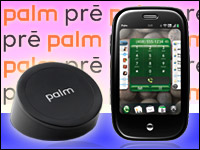
The media buzz around the Palm Pre is rising to deafening levels as the countdown to the Pre’s release on Saturday proceeds.
Generally, early reviewers like its design and ease of use.
The device’s short battery life and small keyboard were concerns. However, the battery can be swapped out easily, unlike the iPhone’s, the Apple handset with which the Pre is often compared. Little can be done about the Pre’s keyboard.
Starting on Saturday, we will begin to see whether the Pre will help Palm turn its battered fortunes around.
Will the Pre Succeed?
However, the Pre handset itself is not as important to Palm as is its webOS, IDC analyst Ramon Llamas said. WebOS is the new Palm operating system the Pre uses. “The Pre is just one Palm device, and they’ll be putting out other devices running webOS,” he told TechNewsWorld.
“Palm is really betting its future on webOS,” he said.
The Pre could be a money-spinner, said Scott Sutherland, managing director of analyst firm Wedbush Morgan. Every year, half of Sprint’s 50 million customers have to renew their two-year contracts, he told TechNewsWorld.
That makes for about 6 million contracts renewed every quarter. “If one in six get a Pre, that’s 1 million Pre users, and Sprint is attracting new subscribers,” Sutherland said.
Other carriers will also be offering the Pre soon, which raises its chances of being profitable. “They’re getting device, developer and carrier support,” Sutherland said. “Carriers are lining up to carry the Pre. AT&T, T-Mobile and Verizon already carry other Palm devices.”
Lavishing Love on the Pre
Early reviews on the handset have been somewhat encouraging. The Pre is a strong competitor to the iPhone, in the estimation of The Wall Street Journal’s Walter Mossberg. However, he said, it has some problems that must be resolved.
Pointing out that the man behind the Pre is ex-Apple executive Jon Rubinstein, The New York Times’ David Pogue described the device as “the iPhone remixed.”
PC Magazine’s reviewer Sascha Segan considers the Pre the coolest handheld device to come around in a long time and said getting a Pre would be worth switching carriers to Sprint. She gave it a “very good” rating.
Meanwhile, PC World’s Ginny Mies gave it a score of 83 out of 100 and said it lives up to the hype.
About the Pre Overall
The Pre’s look and feel drew mixed reviews.
Some love it. The Pre’s design is beautiful, according to Mossberg, and it feels great in the hand. Still, the buttons feel rubbery to him and don’t stick out far enough from the device’s body to be easily pushed.
The device looks great, agreed Pogue. Being a little smaller than the iPhone, he added, it’s exactly the right size.
Others are not quite that keen on the Pre’s hardware.
The Pre sacrificed keyboard usability for compactness, in the opinion of PC World’s Mies. The keyboard is way too small, she stated. Fellow PC World reviewer Melissa Perenson agreed.
The Touchscreen Interface
The Pre’s touchscreen interface also got mixed reviews.
Some like it. It’s equal to — or perhaps better than — the iPhone’s, Mossberg wrote. It also drew raves from Mies, Perenson and Pogue.
However, PC Magazine’s Segan is ambivalent. The touchscreen is crystal-clear and very responsive, she said, but she pointed out that the screen rotates only when the user is viewing videos, photos and Web pages, and not at other times.
Love That webOS – Mostly
The debut of the Palm Pre handset will also mark the debut of webOS, Palm’s new mobile operating system. The new OS drew lots of praise — The New York Times’ Pogue pointed out that it borrows a lot from the iPhone and described it as attractive and exciting.
WebOS uses a sort of playing-card metaphor rather than a desktop metaphor. Each program or window appears as a virtual card on the Pre’s touchscreen. Users can flip through the cards and zoom in or out. To get rid of a card, the user flicks it off the screen. That closes down the application or window.
It’s a well-though-out way to handle applications, said PC Magazine’s Segan.
As smartphone operating systems go, webOS is on par with the iPhone OS and Google’s Android, according to Mies. However, she pointed out that apps sometimes loaded slowly, and the placement or organization of some features was confusing.
Synergy Simplifies Things
Synergy, a new feature on the Palm Pre, brings Outlook, Google and Facebook calendars together to give users one view. It also groups all conversations with the same person into one chat-style view, even if the user employs different applications, such as instant messaging and text messaging, at different times. Synergy also synchronizes the Pre’s contact list with those of Exchange, Facebook and Google.
Synergy is one of the Pre’s standout features, according to Segan. However, Palm needs to do more, she said. Facebook e-mails, instant messages and events do not appear in any of the Pre’s built-in apps, and Synergy does not give users contacts and calendars for Windows Live and Yahoo, Segan says.
Also, Pre does not sync with MySpace or Twitter, she pointed out.
With some items, Pre’s syncing was not carried out instantaneously, according to Mossberg.
Gripes About the Pre
The Pre’s keyboard left some reviewers unhappy — too sticky and too small were a couple of common complaints.
Though Palm plans to let third-party developers create applications for the webOS platform, its app selection pales in comparison to the thousands offered by Apple, which opened its App Store a year ago. This lack of apps is a serious issue, according to the Journal’s Mossberg.
Rreviewers also complain about the short battery life, although they say it’s easy to swap out the battery. That gives the Pre an edge over the iPhone, the battery in which cannot be swapped without disassembling the device, they said.





















































